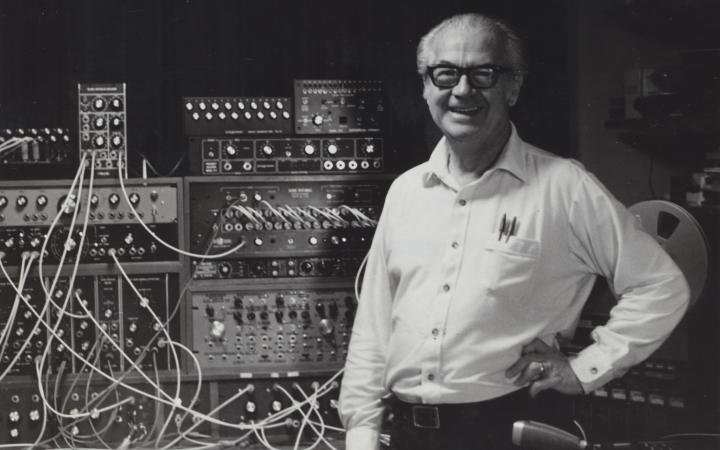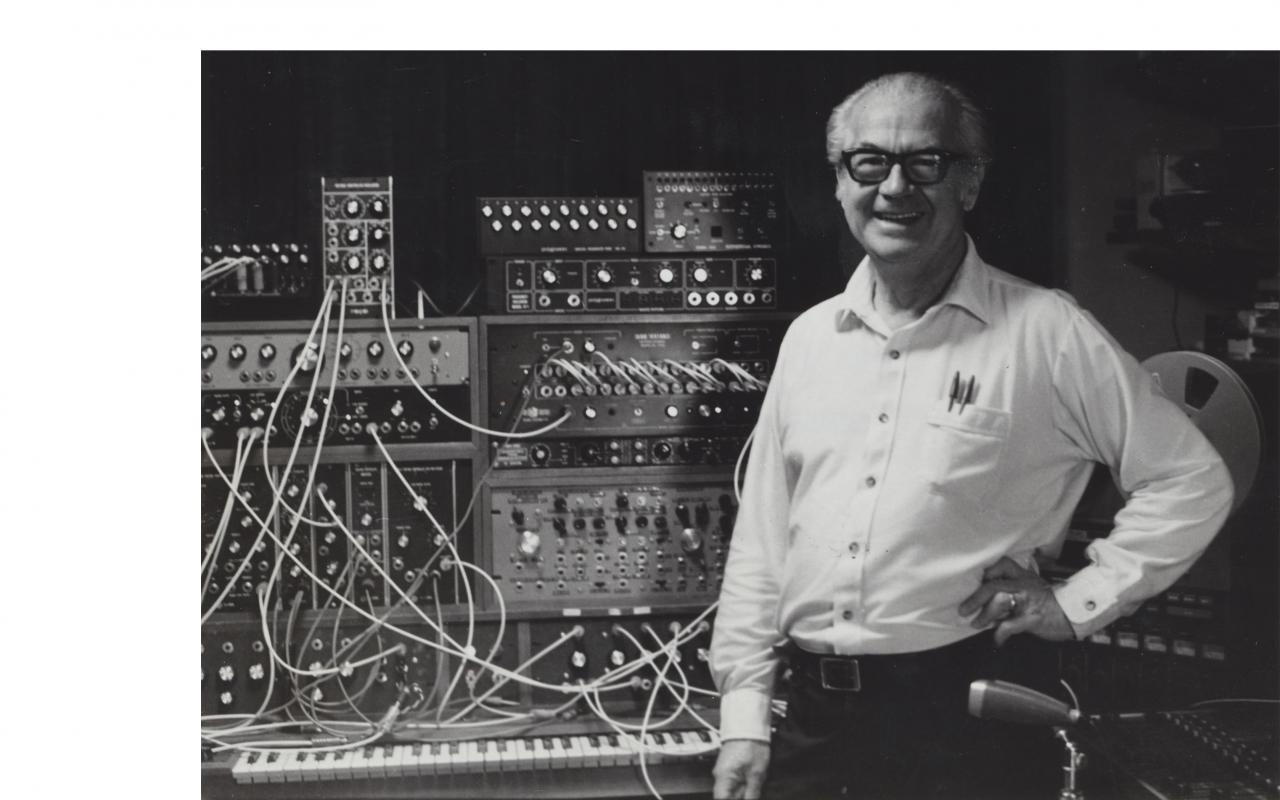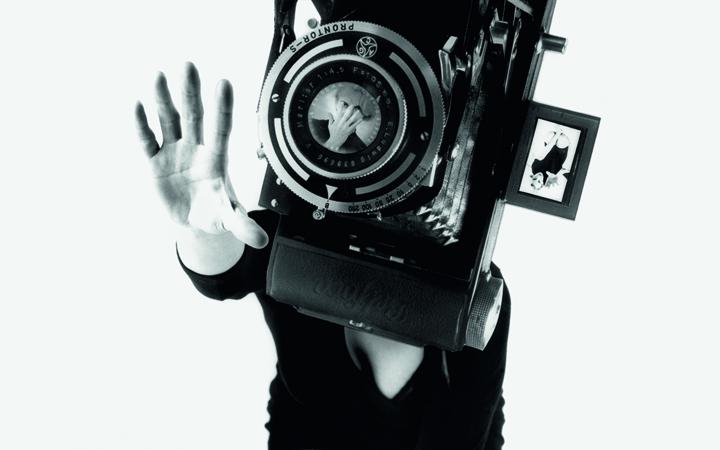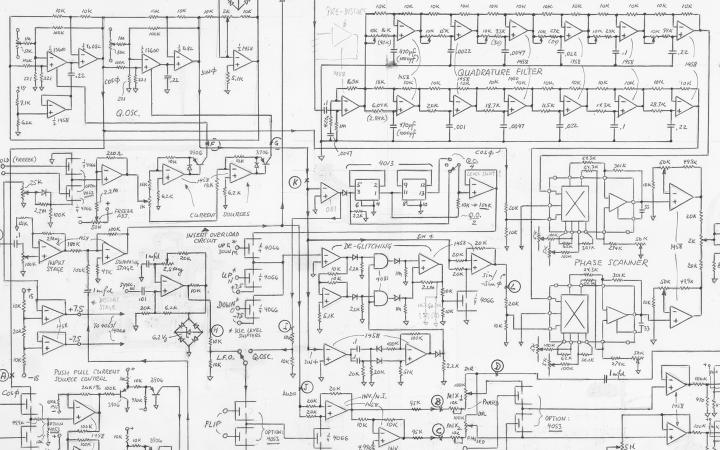Harald Bode

- Year of birth, place
- 1909, Hamburg, Germany
- Year of death, place
- 1987, New York, United States
- Role at the ZKM
- in the archives
- Biography
Harald Bode Estate at ZKM | Archive: LINK
Harald Bode was born 1909 in the bustling port city of Hamburg, Germany. He grew up in a home surrounded by love and music. His father Maximillion Bode taught and played pipe organ, while his mother Dagmar played the harpsichord.
Young Harald was intrigued by the possibilities of both physics and music.
I had always the desire to create the means to express myself in a new way (musically)… to bring about sounds, which I visualized… sounds which I thought would be possible.
(Harald Bode, 1979)
This vision would become the æsthetic drive behind his electronic music instrument designs. At the young age of 18 Harald’s life took a drastic shift: he lost both parents and went to live with his elderly great aunt.
Harald worked and put himself through university studying mathematics, physics and natural philosophy and graduated from Hamburg University in 1934. It was in 1935 that Harald began his work in the field of electronic music instruments. In 1937, with funding support provided by Christian Warnke, Harald created the Warbo-Formant Organ.
It was a radical design, a formant type organ with a special circuit, in which four tone generators could generate the sounds for the entire 44-key keyboard. The instrument was polyphonic, most remarkable for the period, made sound completely by electronic means and could create new sounds freely by adjusting its half-rotary and stop knobs.
In early spring of 1938, following his success with the Warbo-Formant Organ, Harald moved to Berlin and did postgraduate study at the Heinrich Hertz Institute. There he worked on an electromechanical instrument similar to the Hammond, but exceeding it both technically and in performance. During this time along with collaborators Oskar Vierling and Fekko von Ompteda, Harald developed his own instrument, the Melodium, a monophonic melody instrument with touch-sensitive keyboard and multi-timbre capability.
Being a monophonic instrument the Melodium would present far fewer tuning problems than the Warbo-Formant Organ. The instrument was used extensively in film scores of the period, where it often supplied a moody melody line. It was during this period that Harald decided electronic musical instruments would be »the task of my life time« (Harald Bode, 1957) but this task was to be put on hold.
The year 1939 arrived and as Harald put it »we had the only choice in Germany, to go to military service or do work for the government. I praise myself lucky, that I was able to go to the electronic industry« (Harald Bode, 1957). Harald worked on projects for submarine sound and wireless communication. He moved from Berlin with his new wife Irmgard to the small village Neubeuern in the Alps of southern Germany, where his first son Ralf was born. It was there in his attic lab that Harald built the first European post-war electronic instrument, the 1947 version of the Melochord.
The instrument was stunning in its sound quality and welcome news to a war-weary country, where it made major news and was promoted in press and radio. The Melochord was a two-tone melody keyboard instrument with foot controls and a variety of performance features including a formant clavier, white noise tone generator with various attack decay and percussion envelope capabilities, formant filters with continuous variable attenuation and ring modulators for harmonics.
Professor Meyer-Eppler ordered a Melochord from Harald and it was one of two instruments specially commissioned for the new Studio für Elektronische Musik in Cologne, Germany.
The Melochord required high skills to operate, so in 1949 Harald set on a new design called the Polychord. This was a polyphonic keyboard instrument, which included some instrument presets and was designed similar to an organ. In 1951 Harald decided to build a synthesis type organ, the Polychord III, manufactured by the German company AWB, followed by the Bode Organ, which became the principal design behind the Estey Electronic Organ.
Then in 1953 Harald left this organization and developed the Tuttivox, a miniature electronic organ and a vital part of the Clavioline, which were both big sellers throughout Europe.
In 1954 Harald along with his family, which now also included his two-year-old son Peer, moved to the USA, settling in Brattleboro, Vermont.
He had been hired by the Estey Organ Corporation to be the Vice-President and Director of Research and Development. Harald was looking to move to the US and through common contacts Elisabeth McKay offered Harald the job. With this contract for Estey, Harald set upon a new challenge, to create a cost-effective, mass-produced electronic organ targeted for the American mass market. It was a challenge that Harald and his talented young team of designers and engineers did realize, but did not come to pass as the Estey Organ Company closed its doors under bankruptcy in 1960.
The advanced Estey Electronic Organ was set to compete with the major American manufactures of the day and Harald had every faith in the Estey team »by the wonderful cooperation proven to us and by the know-how and sincere efforts of the Estey staff we know that we will also take this hurdle« (Bode [date unknown]). Advances in the keyboard wiring meant the organ was more consistent and cost effective to manufacture. The Estey team made advancements in switch contact wiring and designed a new key switch assembly. They also overcame noise spill coming off the tone generators, built tuneable tone generators and developed etched circuit designs.
As well, the Estey Lab developed an integrated and stable main chassis, no small feat as this is the heart of the organ and a complex of components, including the organ’s power supply, regulator circuitry, main power audio amp, preamp stages of the audio amplifier, input filter network, pedal tone divider circuit, vibrato oscillator and high »C« note for the entire organ. Besides the organ, the Estey Electronics Lab built prototypes for experimental percussive sidemen and tone cabinets. 1956 and 1957 were a particularly productive period as the team moved from the Estey Model S to the advanced Model AS-1, a ready contender for the US market.
In 1958 Harald negotiated part-time status with the Estey company and devoted himself to developing a new product line for the fledgling Bode Electronics Company, located in Brattleboro, Vermont. Coming off the highly productive years of 1956 through 1957 Harald was ripe to pursue not-before-imagined developments. As early as March 1960 Harald had sent out a demo tape for his new instrument and in October of that year, he presented it at the Audio Engineering Society convention as »A New Tool for the Exploration of Unknown Electronic Music Instrument Performances« (Harald Bode, 1960). This instrument later became known as the Audio System Synthesizer.
The System included a conventional tape deck, tape loop reverberation and plug-in modules. Harald had built the first patchable modular system with control voltage capability, and was aware of the instrument’s significance, declaring »we can visualize that the device may become an indispensable piece of equipment for modern production studios that involve sound« (Harald Bode, 1960). The young Bob Moog took Harald’s concept to heart and from it designed his own renowned Moog Synthesizers.
The Audio System Synthesizer marked the start of a new type of instrument, one no longer limited to a keyboard input but that could instead take any sound source as input. In 1962 Harald started a long relationship with composer Vladimir Ussachevski. This relationship proved fertile ground for the development of the Bode Ring Modulators and Klangumwandlers. Ussachevski purchased and commissioned a number of the advances for these instruments.
The Klangumwandler (also known as a frequency shifter) is capable of changing a sound’s overtones and consequently its characteristics. The Bode Klangumwandler had a more broad altered range and is noted for its rich sound. The ring modulator can mix two voltages into one constant voltage, and although it was used widely in other electronic applications, its use in sound modification was limited. Harald first worked with the ring modulator under request through Meyer-Eppler’s commission for the 1953 Cologne Melochord and incorporated it into his Audio System Synthesizer. In 1966 Bode entered into a business arrangement with Bob Moog to build — to Harald’s exact specifications — the Bode Ring Modulators and Bode Frequency Shifter.
At the 1972 Audio Engineering Society conference, Harald and Bob Moog presented their new High Accuracy Frequency Shifter, which featured a voltage-controlled oscillator and control voltage programmable shifts to and through zero (Bode and Moog 1972). The instrument now had far more developed capability. Harald would continue to develop his frequency shifters, including an anti-feedback shifter through to the 1980s.
1972 marked the start of the Bode Sound Company and in that same year Harald lost Irmgard, his loving wife of 35 years. Two years later he retired from Bell Aerospace, where he had spent the last ten years developing micro-circuitry.
No longer under contract to Bell, Harald looked forward to expanding the business he now ran with his new wife Jean, and at last developing the instrument he had imagined in 1949, a Bode Vocoder.
The Bode Vocoder had a special patented feature which could allow direct through feed of consonants like »s« and »t« to pass though along with the processed sounds which allowed for clarity in understanding speech. As well, with this feature the processed signal was not influenced by these percussive higher frequencies, which gave the Bode Vocoder its distinct rich musical sound.
The 1981 Barberpole Phaser is based on the psychoacoustic principles of the Shepard tone and the Shepard-Risset glissando, first discovered in the 1960s. Harald made analogue test recordings of a Shepard tone and developed his own infinite phaser giving it the trademarked name Barberpole Phaser. He presented the effect and its musical application at the October 1981 AES convention. The exact number of Barberpole Phasers built is uncertain but likely only three were finished.
The early eighties saw the implementation of the MIDI standard and a new generation of keyboard preset synthesizers arrive on the market and consequently the demand for sound processors fell off. Harald reflected on this change:
When I think of all the instruments offered on the market… and the restrictions in style, which they may dictate ultimately… and then I think of the simplicity of the modular approach and the flexibility it affords and the freedom of movement within styles… this is just another way back to the traditional sounds… and a step away from the integration of the new with the traditional.
(Harald Bode, 1984)
Harald questioned this next generation of keyboard synthesizers but also saw this time as an opportunity to focus on new development.
He actively entered the digital computer age, writing programs on his Commodore 64 for everything from print-plot programs, to rhythm programs played out of the SID chip, to running complex calculations for a next generation of dome filters, to a new hardware design for a computer control voltage interface. Harald wrote that the computer is a thing to do all he ever liked to do; math, writing and music (Harald Bode, 1978). Also his final years mark a relaxation in his life: he focuses more on his compositions, takes up photography, does more contemplative writing and model building. In 1986 Harald becomes fatigued and is later diagnosed with cancer and died in early January 1987.
In a 1980 interview, Jim Finch asked Harald to offer his advice to aspiring artists and technologists, and he responded:
Well, I would say this… don’t try to imitate. The bandwagon effect is something that is being done so much today. Everybody seems to always try to imitate another who is successful. Don’t do this, try to really think and be original.
(Harald Bode,1980)
The text »Harald Bode — A Short Biography«, by Rebekkah Palov is original published in eContact! 13.4.


